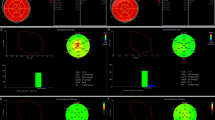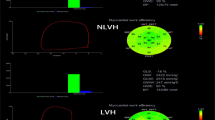Abstract
Objective
The research was aimed to evaluate the subclinical left ventricular (LV) myocardial systolic dysfunction in T2DM patients with or without hypertension (HT) by global and segmental myocardial work (MW).
Methods
A total of 120 T2DM patients (including 60 T2DM patients with HT) and 70 sex- and age- matched normal controls were included. The global and segmental variables of work index (WI), constrictive work (CW), waste work (WW), work efficiency (WE), and CW/WW were analysed by non-invasive pressure-strain loop. Receiver operating characteristic (ROC) analysis was performed for detection the subclinical LV systolic dysfunction in T2DM patients with and without HT.
Results
The global work index (GWI), global CW (GCW), global WE (GWE), and GCW/global WW (GWW) of T2DM and T2DM patients with HT were significantly lower than normal controls (p < 0.05). The WI, CW, WE, and CW/WW of the LV anterior wall in T2DM and T2DM patients with HT were significantly lower when compared with those of the normal controls (p < 0.05). ROC analysis showed that the value of area under the curve (AUC) in combined GWI, GCW, GWE, and GCW/GWW was significantly higher than the AUCs of the individual indices (p < 0.05).
Conclusions
MW can non-invasively and accurately evaluate subclinical global and segmental LV myocardial systolic dysfunction in T2DM patients with and without HT. Regulating total cholesterol levels and controlling blood pressure in T2DM patients with and without HT might reduce the impairment of LV myocardial systolic function.
Similar content being viewed by others
Introduction
With the growth of the population and increased longevity, non-infectious chronic diseases (NCDs) are still the main causes of poor health worldwide. In a report released by the World Health Organization in 2022 [1], as one of the most common NCDs, type 2 diabetes mellitus (T2DM) has shown an increasing trend in both incidence and mortality over the last 20 years. Cardiovascular complications are viewed as dangerous complications of T2DM culminating in death [2]. Although ischaemic events dominate cardiovascular complications, in the absence of myocardial ischaemia and conditions of hypertension, diabetic cardiomyopathy also carries an increased risk of progression to heart failure [3]. In previous studies in which left ventricular (LV) global longitudinal strain (GLS) was measured using speckle-tracking echocardiography (STE), patients with T2DM who developed myocardial dysfunction could be identified even when LV ejection fraction (LVEF) was preserved [4, 5]. The acquisition of LV global radial, circumferential, and longitudinal strain by cardiovascular magnetic resonance (CMR) tissue tracking also enables the evaluation of myocardial systolic function in T2DM patients [ MW can non-invasively evaluate subclinical global and segmental LV myocardial systolic dysfunction in T2DM patients with and without HT. TC and SBP were independent influencing factors for GCW in T2DM patients with and without HT. Regulating total cholesterol levels and controlling blood pressure in T2DM patients with and without HT might reduce the impairment of LV myocardial systolic function. There are still some limitations in the present study. First, patients with poor image quality due to obesity, smoking, etc., were excluded, so this exclusion criterion may be biased for different operators. Furthermore, the present study was a single-centre study, and multicentre large sample studies are needed to further provide reference value for this finding.Conclusion
Limitations
Availability of data and materials
The datasets used and analysed during the current study are available from the corresponding author on reasonable request.
Abbreviations
- BMI:
-
Body mass index
- BSA:
-
Body surface area
- SBP:
-
Systolic blood pressure
- DBP:
-
Diastolic blood pressure
- HbA1c:
-
Glycosylated hemoglobin A1c
- TC:
-
Total cholesterol
- TG:
-
Triglyceride
- HDL-C:
-
High-density lipoprotein cholesterol
- LDL-C:
-
Low-density lipoprotein cholesterol
- FPG:
-
Fasting plasma glucose
- BUN:
-
Blood urea nitrogen
- SCR:
-
Serum creatinine
- LA:
-
Left atrial
- LAV:
-
Left atrial volume
- IVS:
-
Interventricular septum
- PW:
-
Posterior wall
- LV:
-
Left ventricular
- LVEDV:
-
LV end-diastolic volume
- LVESV:
-
LV end-systolic volume
- LVEF:
-
Left ventricular ejection fraction
- MAPSE:
-
Mitral annular plane systolic excursion
- LVGLS:
-
LV global longitudinal strain
- GWI:
-
Global myocardial work index
- GCW:
-
Global constructive work
- GWW:
-
Global waste work
- GWE:
-
Global work efficiency
References
Organization WH. World Health Statistics 2022. 2022.
Shah A, Isath A, Aronow WS. Cardiovascular complications of diabetes. Expert Rev Endocrinol Metab. 2022;17:383–8.
Bugger H, Abel ED. Molecular mechanisms of diabetic cardiomyopathy. Diabetologia. 2014;57:660–71.
Zoroufian A, Razmi T, Taghavi-Shavazi M, Lotfi-Tokaldany M, Jalali A. Evaluation of subclinical left ventricular dysfunction in diabetic patients: longitudinal strain velocities and left ventricular dyssynchrony by two-dimensional speckle tracking echocardiography study. Echocardiography. 2014;31:456–63.
Huang D, Cui C, Zheng Q, Li Y, Liu Y, Hu Y, et al. Quantitative analysis of myocardial work by non-invasive left ventricular pressure-strain loop in patients with type 2 diabetes mellitus. Front Cardiovasc Med. 2021;8: 733339.
**e LJ, Dong ZH, Yang ZG, Deng MY, Gao Y, Jiang L, et al. Assessment of left ventricular deformation in patients with type 2 diabetes mellitus by cardiac magnetic resonance tissue tracking. Sci Rep. 2020;10:13126.
Roemer S, Jaglan A, Santos D, Umland M, Jain R, Tajik AJ, et al. The utility of myocardial work in clinical practice. J Am Soc Echocardiogr. 2021;34:807–18.
Lee SE, Nguyen C, **e Y, Deng Z, Zhou Z, Li D, et al. Recent advances in cardiac magnetic resonance imaging. Kor Circul J. 2019;49:146–59.
Russell K, Eriksen M, Aaberge L, Wilhelmsen N, Skulstad H, Gjesdal O, et al. Assessment of wasted myocardial work: a novel method to quantify energy loss due to uncoordinated left ventricular contractions. Am J Physiol Heart Circ Physiol. 2013;305:H996-1003.
Russell K, Eriksen M, Aaberge L, Wilhelmsen N, Skulstad H, Remme EW, et al. A novel clinical method for quantification of regional left ventricular pressure-strain loop area: a non-invasive index of myocardial work. Eur Heart J. 2012;33:724–33.
Wang T, Li L, Huang J, Fan L. Assessment of subclinical left ventricle myocardial dysfunction using global myocardial work in type 2 diabetes mellitus patients with preserved left ventricle ejection fraction. Diabetol Metab Syndr. 2022;14:17.
American DA. Diagnosis and classification of diabetes mellitus. Diabetes Care. 2013;36(Suppl 1):S67-74.
Williams B, Mancia G, Spiering W, Agabiti Rosei E, Azizi M, Burnier M, et al. ESC/ESH Guidelines for the management of arterial hypertension: The Task Force for the management of arterial hypertension of the European Society of Cardiology and the European Society of Hypertension. 2018;2018(36):1953–2041.
Lang RM, Badano LP, Mor-Avi V, Afilalo J, Armstrong A, Ernande L, et al. Recommendations for cardiac chamber quantification by echocardiography in adults: an update from the American Society of Echocardiography and the European Association of Cardiovascular Imaging. J Am Soc Echocardiogr. 2015;28(1–39): e14.
Nagueh SF, Smiseth OA, Appleton CP, Byrd BF 3rd, Dokainish H, Edvardsen T, et al. Recommendations for the evaluation of left ventricular diastolic function by echocardiography: an update from the american society of echocardiography and the European Association of Cardiovascular Imaging. J Am Soc Echocardiogr. 2016;29:277–314.
Matos J, Kronzon I, Panagopoulos G, Perk G. Mitral annular plane systolic excursion as a surrogate for left ventricular ejection fraction. J Am Soc Echocardiogr. 2012;25:969–74.
Park JJ. Epidemiology, pathophysiology, diagnosis and treatment of heart failure in diabetes. Diabetes Metab J. 2021;45:146–57.
Dillmann WH. Diabetic cardiomyopathy. Circ Res. 2019;124:1160–2.
Poirier P, Bogaty P, Garneau C, Marois L, Dumesnil JG. Diastolic dysfunction in normotensive men with well-controlled type 2 diabetes: importance of maneuvers in echocardiographic screening for preclinical diabetic cardiomyopathy. Diabetes Care. 2001;24:5–10.
From AM, Scott CG, Chen HH. The development of heart failure in patients with diabetes mellitus and pre-clinical diastolic dysfunction a population-based study. J Am Coll Cardiol. 2010;55:300–5.
Ernande L, Bergerot C, Rietzschel ER, De Buyzere ML, Thibault H, Pignonblanc PG, et al. Diastolic dysfunction in patients with type 2 diabetes mellitus: is it really the first marker of diabetic cardiomyopathy? J Am Soc Echocardiogr. 2011;24:1268-75.e1.
Edwards NFA, Scalia GM, Shiino K, Sabapathy S, Anderson B, Chamberlain R, et al. Global myocardial work is superior to global longitudinal strain to predict significant coronary artery disease in patients with normal left ventricular function and wall motion. J Am Soc Echocardiogr. 2019;32:947–57.
Hiemstra YL, van der Bijl P, El Mahdiui M, Bax JJ, Delgado V, Marsan NA. Myocardial work in nonobstructive hypertrophic cardiomyopathy: implications for outcome. J Am Soc Echocardiogr. 2020;33:1201–8.
Ilardi F, Postolache A, Dulgheru R, Trung MN, de Marneffe N, Sugimoto T, et al. Prognostic value of non-invasive global myocardial work in asymptomatic aortic stenosis. J Clin Med. 2022;11:1.
Tadic M, Cuspidi C, Pencic B, Grassi G, Celic V. Myocardial work in hypertensive patients with and without diabetes: An echocardiographic study. J Clin Hypertens (Greenwich). 2020;22:2121–7.
Chan J, Edwards NFA, Khandheria BK, Shiino K, Sabapathy S, Anderson B, et al. A new approach to assess myocardial work by non-invasive left ventricular pressure-strain relations in hypertension and dilated cardiomyopathy. Eur Heart J Cardiovasc Imaging. 2019;20:31–9.
Jia G, Whaley-Connell A, Sowers JR. Diabetic cardiomyopathy: a hyperglycaemia- and insulin-resistance-induced heart disease. Diabetologia. 2018;61:21–8.
Lee TW, Bai KJ, Lee TI, Chao TF, Kao YH, Chen YJ. PPARs modulate cardiac metabolism and mitochondrial function in diabetes. J Biomed Sci. 2017;24:5.
Nomura K, Ajiro Y, Nakano S, Matsushima M, Yamaguchi Y, Hatakeyama N, et al. Characteristics of mitral valve leaflet length in patients with pectus excavatum: a single center cross-sectional study. PLoS ONE. 2019;14: e0212165.
Sonaglioni A, Nicolosi GL, Trevisan R, Lombardo M, Grasso E, Gensini GF, et al. The influence of pectus excavatum on cardiac kinetics and function in otherwise healthy individuals: A systematic review. Int J Cardiol. 2023;381:135–44.
Acknowledgements
We would like to thank the department of Echocardiography, Cardiology and Endocrinology, the Affiliated Changzhou Second People's Hospital with Nan**g Medical University.
Funding
Changzhou Science and Technique Program (Grant No.: CJ20190098).
Author information
Authors and Affiliations
Contributions
GAL and JH designed the study and carried out the study, data collection and analysis, wrote the manuscript and JH revised the manuscript. GAL and XS collected the T2DM patients and normal controls. LF and JH performed the statistical analysis.
Corresponding author
Ethics declarations
Ethics approval and consent to participate
The study complied with the Declaration of Helsinki and was reviewed and approved by the Human Subjects Committee of Changzhou Second People′s Hospital. Written informed consent was obtained from each couple enrolled in the study.
Consent for publication
This manuscript does not include any individual person′s data.
Competing interests
The authors declared no conflict of interest.
Additional information
Publisher's Note
Springer Nature remains neutral with regard to jurisdictional claims in published maps and institutional affiliations.
Rights and permissions
Open Access This article is licensed under a Creative Commons Attribution 4.0 International License, which permits use, sharing, adaptation, distribution and reproduction in any medium or format, as long as you give appropriate credit to the original author(s) and the source, provide a link to the Creative Commons licence, and indicate if changes were made. The images or other third party material in this article are included in the article's Creative Commons licence, unless indicated otherwise in a credit line to the material. If material is not included in the article's Creative Commons licence and your intended use is not permitted by statutory regulation or exceeds the permitted use, you will need to obtain permission directly from the copyright holder. To view a copy of this licence, visit http://creativecommons.org/licenses/by/4.0/. The Creative Commons Public Domain Dedication waiver (http://creativecommons.org/publicdomain/zero/1.0/) applies to the data made available in this article, unless otherwise stated in a credit line to the data.
About this article
Cite this article
Li, GA., Huang, J., Sheng, X. et al. Assessment of subclinical left ventricular myocardial systolic dysfunction in type 2 diabetes mellitus patients with or without hypertension by global and segmental myocardial work. Diabetol Metab Syndr 15, 200 (2023). https://doi.org/10.1186/s13098-023-01180-0
Received:
Accepted:
Published:
DOI: https://doi.org/10.1186/s13098-023-01180-0




